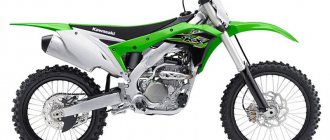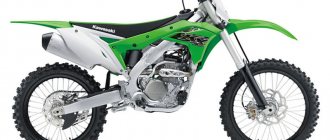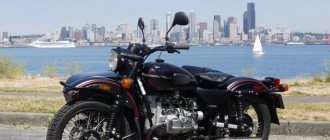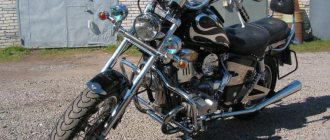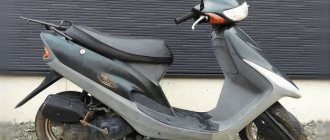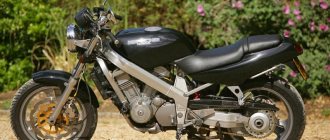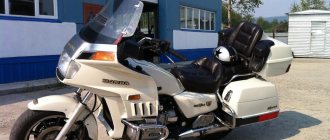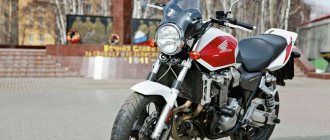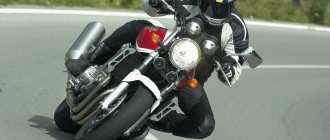Honda CB400F (2013)
Honda CB400F naked model
was introduced in 2013 as a domestic modification of the Honda CB500F. In technical terms and appearance, the CB400F is an exact copy of the CB500F, with the exception of the engine, which has reduced the crankshaft stroke and thereby reduced the volume to 399 cm³ (but increased the compression ratio to 11.0).
The features of the Honda CB400F include a steel frame, simple suspension in the form of a conventional telescopic fork at the front and a monoshock absorber at the rear, a 6-speed gearbox, a 15-liter fuel tank, an injection power system, the availability of versions with ABS and a curb weight of 192 kg.
Unlike the Honda CB500F, the Honda CB400F was only produced in 2013, selling off stock in subsequent years. This was explained by the extremely low demand for the model (by the way, the sports “brother” Honda CBR400R became very popular in Japan and underwent the same restyling as the older version - the Honda CBR500R).
Specifications
Technical characteristics of Honda CB400F:
| Model | Honda CB400F |
| Motorcycle type | naked |
| Year of issue | 2013 |
| Frame | steel diagonal |
| engine's type | 2-cylinder, 4-stroke, in-line |
| Working volume | 399 cm³ |
| Bore/Stroke | 67.0 x 56.6 mm |
| Compression ratio | 11,0:1 |
| Cooling | liquid |
| Number of valves per cylinder | DOHC, 4 valves per cylinder |
| Fuel supply system | injector, PGM-Fi |
| Ignition type | fully transistorized |
| Maximum power | 46.0 hp (34.0 kW) at 9500 rpm |
| Maximum torque | 37.0 Nm (3.8 kgm) at 7500 rpm |
| Clutch | Multi-disc in oil bath, cable drive |
| Transmission | 6-speed |
| type of drive | chain |
| Front tire size | 120/70ZR17 M/C (58W) |
| Rear tire size | 160/60ZR17 M/C (69W) |
| Front brakes | 1 disc 320 mm, 2-piston caliper (CB400FA - ABS) |
| Rear brakes | 1 disc 240 mm, 1 piston caliper (CB400FA - ABS) |
| Front suspension | 41 mm telescopic fork (non-adjustable), travel - 122 mm |
| Rear suspension | pendulum Pro-Link with monoshock absorber (adjustable preload), stroke - 105 mm |
| Length | 2075 mm |
| Width | 780 mm |
| Height | 1060 mm |
| Wheelbase | 1410 mm |
| Minimum ground clearance (clearance) | 155 mm |
| Seat height | 785 mm |
| Acceleration 0-100 km/h (0-60 mph) | |
| Maximum speed | |
| Gas tank capacity | 15.0 l |
| Motorcycle weight (curb) | 190 kg – CB400F 192 kg – CB400FA (ABS) |
Honda CB 400 line
HONDA CB400 Super Four.
HONDA CB400 Super Four Bold'or.
The line is divided into two directions:
- HONDA cb400 Super Four - naked version with round headlight
- HONDA cb400 Super Four Bold'or - version with front fairing and square headlight.
With the exception of the external design, the models are identical. Both have the same filling, running capabilities and characteristics.
Design
Honda CB 400 Super Four – right view.
Honda CB 400 Super Four – left view.
Despite the large number of changes that took place during the life of the model at the factory, the production materials remained unchanged. The motorcycle frame is made of steel using a two-pipe duplex system.
The number of weld points is reduced to a minimum through high precision casting technologies . Everything in total gives a fairly rigid and at the same time lightweight structure.
Peculiarities
Front fork.
Rear shock absorber.
A telescopic fork at the front is already considered a classic, but it was the CB 400 that became the first carrier of this option.
Since 2008, the working stroke is 120 mm , the metal thickness is 42 mm . When developing the rear part, the Japanese departed from the standards, thereby increasing the comfort of the motorcyclist. The bike is equipped with a 2-spring shock absorber with a stroke of 110 mm . It is possible to adjust the preload.
Despite the open appearance, the design of the bike is deep . In case of an accidental fall, or an attempt to lay it down (on any side), the footrests and handles will be the first to be hit. In some cases, caps. The main components important for movement are hidden deeper.
Exterior
Most of the Bold'or fairing is located above the headlight and points upward towards the mirrors. There is no need to describe the rest separately - it is identical for the “fours”.
The BOLDOR version is equipped with a front fairing and a rectangular headlight.
Front end
- The front wing of the model is small, tightly pressed to the tire. At a small height above it there is a round headlight. The reflector is configured very carefully - the road is well illuminated in any operating mode. It is traditionally attached between the fork legs.
On the naked bike version with a round headlight, plastic panels and fairings are completely absent.
- Turn signals are placed on the sides of it. Interestingly, the developers used a diamond shape. The colored glass under the light bulb on the stand looks like a rectangle, but upon examination it is noticeable that it is turned at one angle. The edges looking up and down with a connection between them along the road. There is no black plastic that usually hides the rear part.
The front fender can only be removed by removing the wheel.
- Mirrors are rectangular (there are versions with or without round ones) . In the stock version, they are mounted on the steering wheel with good spacing. The racks are flexible, allowing the driver to adjust the viewing angle independently. If necessary, it can be moved on the steering tube. The height is good, higher than the mirrors of passenger cars. This, as well as the small width of the bike, will allow you to maneuver in traffic without any problems.
Dashboard
Over the entire history of the evolution of the CB 400, it has not received any special changes in instruments. In front of the user are two large, round dials - a tachometer and a speedometer.
Classic “tidy” – minimum electronics and maximum information content.
Interestingly, the odometer has become an LCD and is present under both windows. The developers called it trip1, trip2 . Thanks to the pair, you can compare runs over certain intervals.
The buttons on the left side of the panel can reset the readings to zero . According to users, the feature is useful, but for those who travel a lot, it is pointless. The maximum that can be displayed is 999 km , then automatic zeroing.
On the BOLDOR version, the instruments are covered by a windshield.
The panel is complemented by several sensors scattered between the displays. The turn indicators received their own personal window at the top.
Gas tank
The fuel tank is quite flat and low, so you won’t be able to lie on it at speed. But it can easily accommodate luggage bags.
Perhaps due to the fact that the model is without a fairing, the gas tank, located in a standard place, is lowered as much as possible and spread out in width . The owners place additional bags on its “bed” using a net.
The capacity has not changed since the first models - 18 liters.
Rear end
The motorcycle seat is large, with a clearly defined step. The height difference is insignificant, there is enough space for two people to travel.
The double seat is equally comfortable for both driver and passenger.
Behind the back of the second number there is space for installing a trunk. There is no classic bike rack.
All optics are located under the frame stem. Unlike the front part, everything here is LED .
The LED rear light is mounted in a plastic fairing.
The long mudguard provides good protection even without installing panniers. Some craftsmen installed three drawers (+2 on the sides) on the cb400.
There are a lot of wardrobe systems for Sibukha to suit every taste.
Repair and service
This motorcycle is the most common, so there will be no problems with repairs and purchasing spare parts. Maintenance is quite inexpensive, but even with a little diligence and basic knowledge of technology, you can repair a motorcycle yourself.
Prices for spare parts and consumables are not high, with the exception of spark plugs. A set of sprockets and chain will cost about 6000-7500 rubles, an oil filter - 400-500 rubles, an air filter - about 500 rubles. The engine oil volume for the regular version of the CB400 when replaced with a filter is approximately 3.6 liters, and for the vtec version ~3.8 liters.
One of the known problems, like most Hondas, is a flying charging relay. This malfunction most often occurs due to a completely dead battery or poor contact (oxidation of the connector). To avoid charging problems and relay failure, it is recommended to constantly monitor the condition of the battery and periodically clean the connector itself.
Reviews about CB 400
An ordinary classic with a steel frame, simple suspensions with a minimum of adjustments. But, despite this, the popularity of “Sibukha” can be the envy of many competitors.
Before looking for disadvantages in this bike, it is worth remembering that its production began almost 40 years ago , and the reliability, safety, ease of operation and repair of Honda equipment have long been legendary.
- Suspension problems . There is no way to somehow adjust a very soft fork.
- Electrical problems . Lack of standard batteries for everything needed for work. By installing a more powerful one, you can burn some of the instruments on the panel and under it.
- Motorcycle for schoolchildren . Because of its simplicity, the bike could be taken by a beginner and put to good use somewhere. If it is not noticeable outwardly, it is not a fact that it will not come out later in a breakdown.
Many things cannot be called problems, but if the user wants to sit on it and not under it, at least basic maintenance must be done immediately after purchase.
and dignity
If you don’t intentionally kill the device, then it looks like nothing will ever break here.
More advantages are listed:
- maneuverability;
- Ease of Management;
- good maintainability;
- low fuel consumption;
- does not cause problems with starting (without suction up to -5)
- constant and strong traction at any speed.
- good underseat rack.
The latter is basically absent on motorcycles, but Honda completes the equipment to the highest standard.
A lot of tuning is offered for the bike, for example, a plow.
Which, by the way, protects the exhaust manifold pipes from dirt.
Who is it suitable for?
The Honda CB 400 seems to be a very good option for everyday movement around the city.
The model is officially sold only in Japan. Therefore, tall Europeans should consider purchasing a taller car.
You can look in the direction of this model, but when purchasing, it is recommended to sit longer and do a long test drive.

